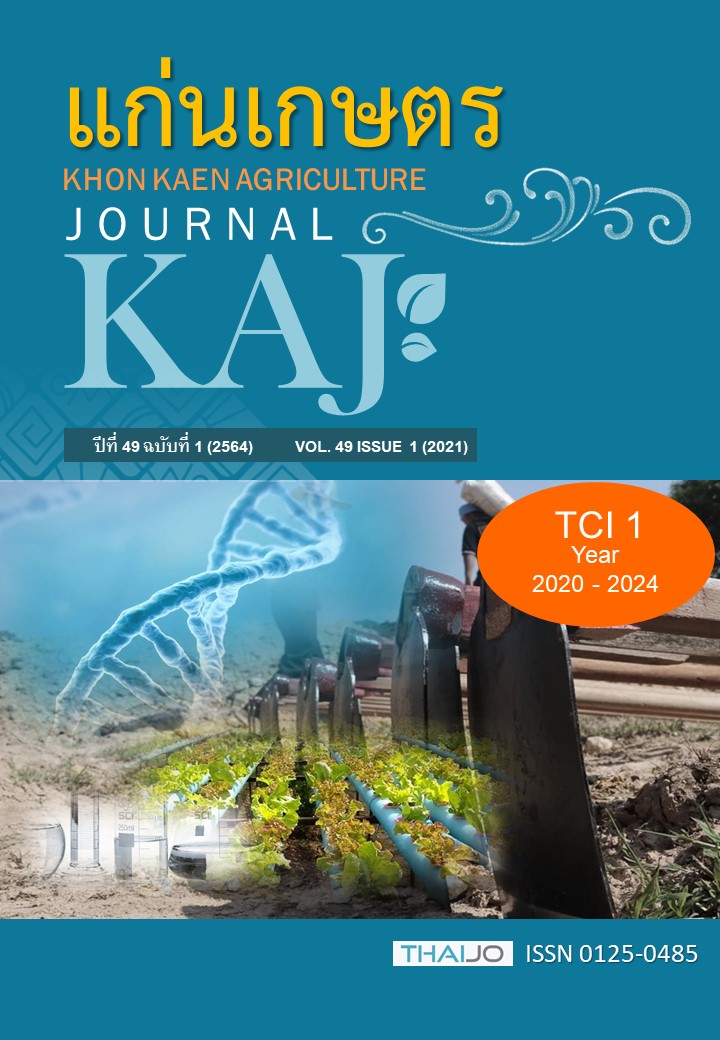การจัดการใบอ้อยเพื่อลดฝุ่นละอองขนาดเล็กและส่งเสริมการผลิตอ้อยอย่างยั่งยืน
Main Article Content
บทคัดย่อ
ประเทศไทยประสบปัญหามลพิษทางอากาศอย่างรุนแรงในบางเวลา เนื่องจากปริมาณฝุ่นละอองขนาดเล็ก (Particulate matter; PM) ได้แก่ฝุ่นละอองขนาดเล็กกว่า 10 (PM10) และ 2.5 ไมครอน (PM2.5) เพิ่มสูงขึ้น และหนึ่งในสาเหตุสำคัญที่ทำให้เกิดฝุ่นละอองขนาดเล็กคือการเผาอ้อยซึ่งเป็นการเผาไหม้ชีวมวลในที่โล่งแจ้ง อ้อยเป็นพืชเศรษฐกิจหลักชนิดหนึ่งของประเทศไทยมีพื้นที่การปลูกทั่วประเทศสูงกว่า 10 ล้านไร่ ในฤดูเก็บเกี่ยวที่ผ่านมาพบว่ากว่า 50% ของปริมาณอ้อยส่งเข้าโรงงานน้ำตาลเป็นอ้อยไฟไหม้ซึ่งถูกเผาที่ระยะเก็บเกี่ยว การเผาอ้อยนั้นพบว่าทำให้เกิดฝุ่นละอองขนาดเล็กมีซิลิเกตเป็นองค์ประกอบหลัก ผลึกของซิลิเกตที่มีขนาดเล็กกว่า 4 ไมครอนถูกระบุว่าคือสาเหตุของมะเร็งปอด การรณรงค์เพื่อลดการเผาอ้อยจึงมีความสำคัญต่อสุขภาพของประชาชนส่วนใหญ่ ประเทศบราซิลซึ่งผลิตอ้อยได้มากเป็นอันดับหนึ่งของโลกประสบความสำเร็จในการลดพื้นที่เผาอ้อยที่ระยะเก็บเกี่ยวจากการใช้มาตรการสีเขียว ผ่านการส่งเสริมการเก็บเกี่ยวอ้อยโดยใช้รถตัดอ้อย อย่างไรก็ตามกลับพบว่าผลผลิตอ้อยต่อพื้นที่เริ่มลดลงหลังการใช้มาตรการดังกล่าว 4 ปี สาเหตุหนึ่งอาจเพราะดินแน่นทึบหลังการใช้เครื่องจักรกลทางการเกษตรขนาดใหญ่อย่างต่อเนื่อง ดังนั้นหากประเทศไทยต้องการรณรงค์ลดการเผาอ้อยโดยใช้มาตรการสีเขียวจึงควรดำเนินการควบคู่กับการปรับปรุงบำรุงดิน อาจเป็นแนวทางที่มีศักยภาพสามารถบรรเทามลพิษทางอากาศ ส่งเสริมความอุดมสมบูรณ์ของระบบการปลูกอ้อยเพื่อให้การผลิตอ้อยของประเทศไทยเป็นมิตรกับสิ่งแวดล้อมอย่างยั่งยืน
Article Details

อนุญาตภายใต้เงื่อนไข Creative Commons Attribution-NonCommercial-NoDerivatives 4.0 International License.
เอกสารอ้างอิง
กรมควบคุมมลพิษ. 2561. ดัชนีคุณภาพอากาศของประเทศไทย. แหล่งข้อมูล: http://www.pcd.go.th/file/28-11-61.pdf. ค้นเมื่อ 1 เมษายน 2563
ปรีชา พราหมณีย์ เจริญ บัวคงดี ประชา ถ้ำทอง อรรถสิทธิ์ บุญธรรม เฉลิมพล ไหลรุ่งเรือง จักรินทร์ ศรัทธาพร มล. จักรานพคุณ ทองใหญ่และพรพิมล ชัยวรรณคุปต์. 2539. การปรับปรุงความอุดมสมบูรณ์ของดินและเพิ่มผลผลิตอ้อยโดยระบบเกษตรยั่งยืน. วารสารวิชาการเกษตร. 14(2): 97-106.
ละอองดาว แสงหล้า, และธวัชชัย ศุภดิษฐ์. 2548. ผลกระทบจากการเผาใบอ้อยและแนวทางการแก้ไข.
แหล่งข้อมูล: http://naduang.loei.doae.go.th/Imager1/032556/do2.pdf. ค้นเมื่อ 16 ตุลาคม 2561
วิชญ์ภาส อีสา, และ วรรณวิภา แก้วประดิษฐ์. 2563. การเปลี่ยนแปลงอินทรีย์คาร์บอนของดินส่วนที่เปลี่ยนแปลงได้ง่ายหลังได้รับการเก็บเกี่ยวอ้อยแบบไม่เผาใบ ภายใต้สภาพดินเหนียวที่ได้รับการเผาใบอย่างเนื่อง. วารสารเกษตรพระวรุณ 17 (1): 21-32.
วิมล ภูกองไชย, และวรรณวิภา แก้วประดิษฐ์. 2561. การจัดการเศษซากใบอ้อยที่ส่งผลต่อการย่อยสลายและปลดปล่อยไนโตรเจน. แก่นเกษตร. 46(ฉบับพิเศษ 1): 25-29.
สำนักงานคณะกรรมการอ้อยและน้ำตาลทราย. 2562. รายงานพื้นที่ปลูกอ้อย ปีการผลิต 2561/62.
แหล่งข้อมูล: http://www.ocsb.go.th/upload/journal/fileupload/923-9040.pdf ค้นเมื่อ 9 มีนาคม 2562
สำนักงานคณะกรรมการอ้อยและน้ำตาลทราย. 2563. รายงานการผลิตอ้อยและน้ำตาลทราย ฤดูการผลิต2562/2563. แหล่งข้อมูล: http://www.sugarzone.in.th. ค้นเมื่อ 30 เมษายน 2563
อิทธิสุนทร นันทกิจ. 2553.การใช้ค่าวิเคราะห์ดินกำหนดการใส่ปุ๋ยและปรับปรุงดินปลูกอ้อย. รายงานฉบับสมบูรณ์โครงการสร้างองค์ความรู้และพัฒนาด้านอ้อยปีงบประมาณ 2553 สำนักงานคณะกรรมการอ้อยและน้ำตาลทราย กระทรวงอุตสาหกรรม.
Amre, D.K., C. Infante-Rivard, A. Dufresne, P.M. Dyrgawale, and P. Ernst. 1999. Case-control study of lung cancer among sugar cane farmers in India. Occupational and Environmental Medicine.58: 548–552.
Ayres, A.S. 1966. Calcium silicate slag as a growth stimulant for sugarcane on low-silicon soils.
Soil Science. 101 (3): 216-227.
Barners, A.C. 1974. The sugarcane. John Wiley & Sons, New York.
Bordonal, R. de O., J.L.N. Carvalho, R. Lal, E.B. de Figueiredo, B.G.de Oliveira, and N.L. Scala Jr. 2018. Sustainability of sugarcane production in Brazil. Agronomy for Sustainable Development. 38: 1-23
Brook, R.D., S. Rajagopalan, C. A. PopeIII, J.R. Brook, A. Bhatnagar, A.V. Diez-Roux, F. Holguin, Y. Hong, R.V. Luepker, M.A. Mittleman, A. Peters, D. Siscovick, S.C. Smith Jr. L. Whitsel, and J.D. Kaufman. 2010. Particulate Matter Air Pollution and Cardiovascular Disease. Circulation. 121: 2331–2378
Calcino, D., B. Schroeder, J. Panitz, A. Hurney, D. Skocaj, A. Wood, and B. Salter. 2018. Australian sugarcane nutrition manual. Sugarcane Research Australia.
Cancado, J.E.D., P.H.N. Saldiva, L.A.A. Pereira, L.B.L.S. Lara, P. Artaxo, L.A. Martinelli, M.A. Arbex, A. Zanobetti, and A.L.F. Braga. 2006. The impact of sugar cane burning emissions on the respiratory system of children and the elderly. Environmental Health Perspectives. 114: 725–729.
Chaddad, F.R. 2010. UNICA: Challenges to Deliver Sustainability in the Brazilian Sugarcane Industry. International Food and Agribusiness Management Review. 13: 173-192
Chekoway, H., J.M. Hughes, H. Weill, N.S. Seixas, and P.A. Demers. 1999. SiO2 exposure, radiological silicosis, and lung cancer mortality in diatomaceous earth industry workers. Thorax. 54: 56–59.
Dalchiavon, F.C., M. de Passos e Carvalho, R. Montanari, M. Andreotti, and E. Augusto Dal Bem. 2013. Sugarcane trash management assessed by the interaction of yield with soil properties. Revista Brasileira de Ciencia do Solo. 37: 1709-1719
de Aquino, G. S., C. de Conti Medina, D.C. da Costa, M. Shahab, and A.D. Santiago. 2017. Sugarcane straw management and its impact on production and development of ratoons. Industrial Crops and Products. 102: 58-64.
Ebenstein, A., M. Fan, M. Greenstone, G. He, and M. Zhou. 2017. New Evidence on the Impact of Sustained Exposure to Air Pollution on Life Expectancy from China’s Huai River Policy. Proceedings of the National Academy of Sciences of the United States of America. 114: 10384–10389.
FAOSTAT. 2016. Sugarcane: Thailand. http://www.fao.org/3/x0513e/x0513e24.htm. Accessed April 25, 2019
FAOSTAT. 2018. Crops. http://www.fao.org/faostat/en/#data/QC. Accessed April 25, 2020
Hemwong, S., G. Cadisch, B. Toomsan, V. Limpinuntana, P. Vityakon, and A. Patanothai. 2008. Dynamics of residue decomposition and N2 fixation of grain legumes upon sugarcane stover retention as an alternative to burning. Soil & Tillage Research. 99: 84-97
Kim, Jong-Hun, In-Hwan Oh, Jae-Hyun Park, and Hae-Kwan Cheong. 2018. Premature deaths attributable to long-term exposure to ambient fine particulate matter in the Republic of Korea. Journal of Korean Medical Science. 33. https://doi.org/10.3346/jkms.2018.33.e251.
Le Blond, J.S., B.J. Williamson, C.J. Horwell, A.K. Monro, C.A. Kirk, and C. Oppenheimer. 2008. Production of potentially hazardous respirable silica airborne particulate from the burning of sugarcane. Atmospheric Environment. 42: 5558-5568
Le Blond, J.S., C.J. Horwell, B.J. Williamson, and C. Oppenheimer. 2010. Generation of crystalline silica from sugarcane burning. Journal of Environmental Monitoring. 12: 1459–1470
Le Blond, J.S., S. Woskie, C.J. Horwell, and B. J. Williamson. 2017. Particulate matter produced during commercial sugarcane harvesting and processing: A respiratory health hazard? Atmospheric Environment. 149: 34-46
Levine, J. S. 2000. Global biomass burning: a case study of the gaseous and particulate emissions released to the atmosphere during the 1997 fires in Kalimantan and Sumatra, Indonesia. In Innes, J., M. Beniston and M. Verstraete (eds). Biomass Burning and its Inter-relationships with the Climate System. Kluwer Academic Publishers: Dordrecht. 15-31 p.
Lisboa, I. P., M. R. Cherubin, R.P. Lima, C.C. Cerri, L.S. Satiro, B.J. Wienhold, M.R. Schmer, V.L. Jin, and C.E. Cerri. 2018. Sugarcane straw removal effects on plant growth and stalk yield. Industrial Crops and Products. 111: 794-806.
Meier, E.A., P.J. Thorburn, M.K. Wegener, and K.E. Basford. 2006. The availability of nitrogen from sugarcane trash on contrasting soil in the wet tropics of North Queensland. Nutrient Cycling in Agroecosystems. 75: 101-114.
Oliveira, M.W., P.C.O. Trivelin, G. Kingston, M.H.P. Barbosa, and A.C. Vitti. 2002. Decomposition and release of nutrients from sugarcane trash in two agriculture environments in Brazil. In: Conference of the Australian society of sugarcane technologists. Proceedings, Cairn, 24; 2002. pp. 1- 10.
Thawaro, N., B. Toomsan, and W. Kaewpradit. 2017. Sweet Sorghum and Upland Rice: Alternative Preceding Crops to Ameliorate Ethanol Production and Soil Sustainability within the Sugarcane Cropping System. Sugar Tech. 19(1): 64-71.
Samuels, G. 1969. Silicon and sugar. Sugar y Azucar. 66: 25-29.
Sornpoon, W., S. Bonnet, P. Kasemsap, P. Prasertsak and S. Garivait. 2014. Estimation of Emissions from Sugarcane Field Burning in Thailand Using Bottom-Up Country-Specific Activity Data. Atmosphere. 5: 669-685
Souza, R.A., T.S. Telles, W. Machado, M. Hungria, J.T. Filho, and M.F. Guimaraes. 2012. Effect of sugarcane harvesting with burning on the chemical and microbiological properties of the soil. Agriculture Ecosystem & Environment. 155: 1-6.
Suma, R., and C.M. Savitha. 2015. Integrated sugarcane trash management: A novel technology for sustaining soil health and sugarcane yield. Advances in Crop Science & Technology. 3: 160-163.


